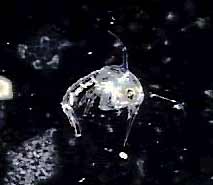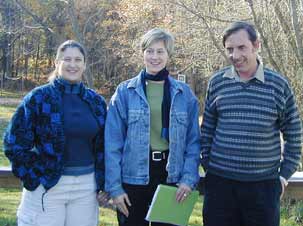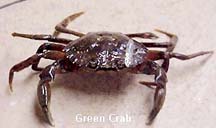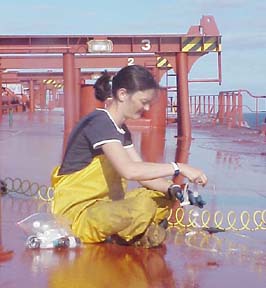|
|
by Martha Blume
photos courtesy of Smithsonian Environmental Research Center
In her lab at the Smithsonian Environmental Research Center in Edgewater, Natasha Gray-Hitchcock invites me to peer into a plastic box. The box is divided into 12 small compartments, and each compartment holds a tiny larval green crab, aka Carcinus maenas zoea. Looking at the nail on my pinkie finger, I figure nine of these could fit there.
 |
 |
 |
| Flow-through topside deballasting, left, is one way to get rid of ballast water at sea. Direct release,middle, is another. Both means help prevent the spread of non-native invader species like those shown from ballast, right. |
“Is this really the face of the enemy?” I wonder.
Across the parking lot in his trailer office, Dr. Paul Fofonoff calls up a map of the world on his computer. On it, blue patches indicate Carcinus’ native habitat in the north and east Atlantic. Lots of red patches show the waters it has invaded since the early 19th century. These include the mouth of the Chesapeake, the entire Atlantic Coast of the United States and the Pacific Coast, stretching up toward Alaska.
For the past eight years, Fofonoff has catalogued species introduced into the Chesapeake Bay since Captain John Smith dropped anchor in 1608. His Nonindigenous Species Database for the Chesapeake Bay lists 294 entries. He has compiled similar databases for the Atlantic, Pacific and Gulf Coasts and a global database of species that have invaded waters around the world.
I imagine a secret amphibious assault, along the lines of D-Day. These invaders do mainly travel by ship. There is no hope of forced retreat or capture of prisoners once their invasion is successful. And any counter-invasion only magnifies the problem.
In a given day, thousands of species are making transocean voyages as well as port-to-port transfers along coastlines. Can the enemy be defeated?
The Invaders
At the National Ballast Water Information Clearinghouse in Edgewater, Greg Ruiz leads the anti-invasionary forces. The clearinghouse — a partnership of the Smithsonian Environmental Research Center and the U.S. Coast Guard — comes to us courtesy of the 1996 National Invasive Species Act. Ruiz and his staff of 30, including Fofonoff at his computer and Gray-Hitchcock in her lab, study the history, costs, rates and patterns of marine invasions.
Invasive species are organisms transported — intentionally or unintentionally — into a region where they did not occur in historical time. They’re also termed “introduced,” “non-indigenous,” “alien” and “non-native.” Some words are nicer than others.
Invasive implies some measure of harm. Think of the microscopic pathogen Haplosporidium nelsoni, which causes the oyster disease MSX. It invaded via foreign oysters in the 1950s and has devastated the native oyster population that was once so hearty that the native oysters could filter all of the Bay’s waters in a matter of days.
Introduced indicates some action on the part of humans — for good or for ill. Consider the stocking of largemouth bass and channel catfish, a boon for recreational and commercial fishing. Then there’s the nutria, native of South America imported to the Eastern Shore in the 1930s to bolster the fur industry. Their root-chomping habits are turning Chesapeake marshes into open waters.
Nonidigenous, alien and non-native all mean the same thing: a species that did not exist in an area during historic time.
The number of invasives has increased exponentially over the course of the past 200 years, probably due in large part to increased ship traffic and transfer of ballast water. Ballast water is the primary vector transporting marine organisms around the world. Chesapeake Bay, including Baltimore and Norfolk harbors, receives more ballast water than any other estuary on the Atlantic coast. Most of our off-loaded ballast comes from northern Europe and the Mediterranean Sea and rolls around in the holds of ships for 10 to 24 days before reaching the Bay.
 |
| A green crab protozea. |
Face of the Enemy
Fofonoff pores over virtual reams of data about some 500 species introduced into North American waters — plus another 200 introduced into Chesapeake Bay alone — over the last 400 years. He finds his data in books, museums and in the minds of species experts, then enters them into his databases.
Every listing includes the vital facts — Invasion status: Is the species a known invader or is it cryogenic, meaning of unknown origin; Date of its first assault; Vector used to get here; Point of origin; Salinity range and geographic distribution; Aliases; and on and on. The European green crab database entry looks like a Wanted, Dead or Alive poster, complete with a mug shot of the crusty-shelled offender.
What does the face of the enemy look like? Fofonoff reads off a litany of the types of species we are “pretty sure” were introduced to the Bay in the last 400 years. The negative effects of these invaders range from predation and competition for food and habitat with native species to hybridization.
They are plants, such as phragmites and Eurasian watermilfoil. They are invertebrates, including the green crab, pocketbook mussel, Asian clam and the crayfish Orconectes virilis — all replacing native populations through competition and predation. They are fish, like the introduced smallmouth and largemouth bass and channel catfish, which have provided economic and recreational value but are voracious predators on smaller native fishes. They are birds, including the mute swan and non-migratory populations of mallards and Canada Geese. They are mammals, such as the nutria and Norway rat. The only criterion for inclusion in the database is the species must be found below the monthly mean high tide line of the Chesapeake.
Lesser known enemies include the microscopic squadrons — the protozoans — such as dermo and MSX, the oyster disease probably introduced with illegal plantings of Japanese oysters around 1959. There are relatively few of these on the list. Because they aren’t here? Not likely, thinks Ruiz. They just haven’t been discovered yet.
Ruiz sees these tiny invaders as big problems. “Bacteria are tolerant of extremes, and many reproduce asexually,” he says of their invasionary advantages.
Another advantage: People aren’t looking for them. For all those reasons, says Ruiz, “it’s more of a worry that they aren’t being discovered because they may present a major hazard.”
Consider that Vibrio cholerae, the pathogen causing human cholera, was found in ballast from a ship traveling from Amsterdam to the United States in 1998.
Imagine a toxic serial killer. Several microscopic algae have been discovered in creeks that drain into the Bay. One, Karlodinium micrum, periodically kills off thousands of fish by release of a toxin when its cells are disturbed. It uses the toxin to immobilize other single-celled organisms 80 percent its own size before it eats them. A school of menhaden passing through calm backwater can cause the toxic release. This is better than science fiction.
War Games
Imagine the enemy occupying a port, confiscating the local food stocks and cutting off the water supply. Sound farfetched? Consider the case of the zebra mussel (Dreissena polymorpha), a victorious invader from the Caspian Sea to the Great Lakes in the mid-1980s.
 |
photo by Cristi Pasquella
Smithsonian scientists keeping their eyes on the aliens: Natasha Gray-Hitchcock, Karen Eason and Paul Fofonoff. |
For an organism to successfully invade a new environment, it must survive a taxing game of ecological roulette. Every step along its journey is fraught with stress and danger. It must be able to travel on a vector, the physical means of transport; survive the journey and the release; reproduce; and finally establish itself in an environment potentially very different from its native habitat in climate, food resources, competitors, predators and parasites.
How do they do it?
The zebra mussels arrived in ships’ ballast water. Most known marine invasions occur with the discharge of ballast water from seagoing ships. Ballast water is taken on to maintain a ship’s trim and stability. It’s usually drawn from bays and estuaries, which are rich in organisms; then, filtered only enough to remove large sticks and debris, it is actively pumped or gravitated into ballast tanks or cargo holds. The ballast water is released at the destination port when cargo is delivered or received.
Travel in ships’ ballast is easy. Organisms don’t have to attach. They aren’t exposed to wide ranges of temperature and salinity as they make their way across the ocean. Once arrived, they spread widely because they attach onto recreational boats and trailers and can survive out of the water for days.
The mussels’ survival strategies further aid their success. A single mussel can produce up to 40,000 eggs a year. They live in dense colonies of up to 700,000 per square meter, attaching to any solid substrate available. First, large zebra mussel populations out-compete native shellfish for food and oxygen. Eventually, they literally surround the natives, choking them out.
Zebra mussels cost an estimated $100 million annually, divided between control measures and repair of damages to water intake pipes and electric generating plants.
 Or consider the green crabs in Gray-Hitchcock’s lab. The crabs may have started coming across the Atlantic, from their native Scandinavia, some 200 years ago as stowaways. Gray-Hitchcock’s four technicians spend eight hours a day studying the temperature and salinity tolerances of larval and juvenile green crabs at each stage of their development. What they’ve found explains the crabs’ incredible invasion success rate. Or consider the green crabs in Gray-Hitchcock’s lab. The crabs may have started coming across the Atlantic, from their native Scandinavia, some 200 years ago as stowaways. Gray-Hitchcock’s four technicians spend eight hours a day studying the temperature and salinity tolerances of larval and juvenile green crabs at each stage of their development. What they’ve found explains the crabs’ incredible invasion success rate.
Juvenile crabs can tolerate temperature differences between 50 and 80 degrees Fahrenheit. Adult crabs can tolerate an even wider range of temperatures. Though tiny, green crabs are voracious scavengers, out-competing shellfish and other crabs as well as wintering shorebirds. Blue crabs and green crabs share similar, wide tolerance ranges of environmental features, occupy similar habitats during their life history, and feed on similar prey. So far the blues have been able to hold their lines. But with a dwindling blue crab population, we may face a future Bay full of green crabs if we don’t win this war.
Adventure on the High Seas
Spurred by the damage done by zebra mussels in the Great Lakes, the Coast Guard wrote management guidelines for ballast water.
It works like this. A ship carrying coal from Norfolk delivers its cargo to an overseas port. At the same time it picks up ballast to maintain trim and stability. When it reaches the open ocean, in water at least 2,000 meters deep and 200 miles from shore, the guidelines demand the ship exchange the ballast in its tanks with mid-ocean water. It returns to the port of Norfolk, discharges its open-ocean ballast water into Chesapeake Bay and picks up more cargo.
Here’s the operating principle. Organisms from coastal zones attempting a free ride in ship’s ballast will die when released in the open ocean. Open-ocean organisms will not survive discharge to coastal zones.
The principle seems simple enough, until you consider the hazards of exchanging large volumes of stabilizing water on the high seas, sometimes compounded by stormy weather. Ships split in half if ballast water is not exchanged safely.
“Think about an Olympic-sized swimming pool,” explained Lt. Cmdr. Mary Pat McKeown of Coast Guard Headquarters Office of Operating and Environmental Standards. “Imagine trying to empty that in a minute. Then imagine a ship with six ballast tanks of that magnitude on board.”
 |
| A Smithsonian research scientist samples released ballast. |
That’s a lot of water to drain, pump or filter. And a lot of muck gets left in the bottom of a ballast tank. In the muck are bacteria, worms, shellfish, crustaceans, plankton and a whole host of potential invaders.
Every minute, 40,000 gallons of foreign ballast water that may contain invasives, including disease-causing pathogens, is dumped into U.S. harbors.
The Coast Guard guidelines, in effect since 1999, are voluntary except for ships discharging ballast in the Great Lakes. This means a lot of ships don’t bother to take the trouble. In the three years since voluntary guidelines have been imposed, only 40 percent of ship traffic from foreign ports submitted reports to the National Ballast Survey. Among those reporting, about half performed some degree of ballast water exchange.
Compliance is higher, however, on the West Coast, where California imposed mandatory ballast exchange and penalties for non-compliance. Maryland is considering similar mandatory legislation.
With a goal of 100 percent compliance, the Coast Guard concedes that voluntary ballast water exchange is not working. So the Secretary of Transportation has proposed new rules to go into effect through 2004. These include a mandatory program of ballast water exchange and incentives for ships to install experimental ballast water treatment technologies.
Will it work? Even the Great Lakes experience can’t give that assurance. “We’ve most likely reduced the amount of invasions that might have occurred without it,” says McKeown. “But it’s nearly impossible to measure. It’s difficult to measure something that didn’t happen.”
Like any war, winning this one will take allies. Even with mandatory U.S. guidelines, ships can discharge ballast in Canada or Mexico, in ports close enough for a full-scale invasion of U.S. waters. The International Marine Organization is working toward international guidelines.
Meanwhile, ballast water treatment is under investigation as a way to avoid waving the flag of surrender. Rather than exchanged, ballast water would be treated in the tanks or at a portside treatment facility. Besides avoiding the dangerous and inefficient open ocean ballast water exchange, treatment would solve the problems of sanitizing ballast water in ships traveling between U.S. ports, which never reach waters deep enough for ballast exchange.
Invasions HQ
“When people look anywhere in the world in great detail, invasions are prevalent,” says Ruiz. Yet when marine ecologists began studying invasions in the 1980s, data showed that the Atlantic Coast wasn’t as heavily invaded as the Pacific. Ruiz, who’s been studying invasions in the Chesapeake since the early 1990s, says nobody had looked closely enough.
It’s such lapses as those that Ruiz and his staff try to fill. He compares data from the Chesapeake Bay with invasion histories in Tampa Bay and San Francisco Bay. He’s constantly looking for patterns and methods to standardize the analysis of invasions. Why? Because good data lead to better regulations.
Such factors as latitude, degree of disturbance and level of biodiversity in a coastal region may effect susceptibility to invasion, Ruiz suspects. To detect new invasions, he’s placed PVC settling plates at 17 sites along the Atlantic, Pacific and Gulf coasts, including Chesapeake Bay, Puget Sound, Narrangansett Bay, San Francisco Bay and Jacksonville, Florida. He also has laid plates on the east and west coasts of Australia. These invertebrate-collecting devices allow technicians to both catalog every species that attaches to the plastic squares and record changes over the course of time. “It gives us a beginning, a baseline, to track,” says Ruiz.
Knowledge gained by the clearinghouse translates into public policy. When policy makers need to judge the efficiency of ballast water exchange, they turn to the clearinghouse’s Karen Eason, who attacks that question with tracers, dyes and microspheres that imitate living organisms.
On another invasionary front, she oversees survivability studies using plankton — tiny plants and animals that float in the water column and make up the base of the marine food chain — as guinea pigs. The tiny prisoners of war are placed in tanks with conditions simulating ballast tanks. Then their survival is tracked. Technicians on her team also measure viability in actual ballast tanks during voyages. From this research, we’ve learned that many more organisms survive shorter trips from Europe than longer trips from the Mediterranean. This gives the defense a better picture of what invasives to expect on our shores.
Can We Win This War?
Ballast isn’t the only vector transporting marine organisms around the globe. There are lots of ways to piggyback from one port to another. Some critters get a free ride on seaweed used for packing the lobster you bought at the grocery, the bait you used to catch a fish or the clam dissected in a biology lab. Some critters attach to sea grasses transplanted for restoration. Others started out as somebody’s pet that didn’t meet the owner’s expectations. Some are escapees from aquaculture or aquariums. Hundreds of thousands ride around on marina floats, dry docks, drilling platforms, floating docks, boat trailers and ship hulls.
Public awareness is part of the battle, but we depend on regulations to win the war. For now, changing the regulations to make ballast water exchange mandatory is a step in the right direction. Ballast water treatment would be even better. Better still is strengthening the National Invasives Species Act.
We don’t have a moment to lose. At the Ballast Water Clearinghouse, Fofonoff’s computerized maps show the invasive troops are on the move. And they have plenty of reinforcements.
 |
About the Author:
Martha Blume is trained in biology and environmental education. She has spent the last seven years as a full-time mother of two daughters, a writer and an advocate. The wife of a Coast Guardsman, she and her family have lived in Connecticut, Maine, New Jersey, Seattle, Anchorage, Rhode Island — and now Arnold, Maryland. |
Copyright 2002
Bay Weekly
|